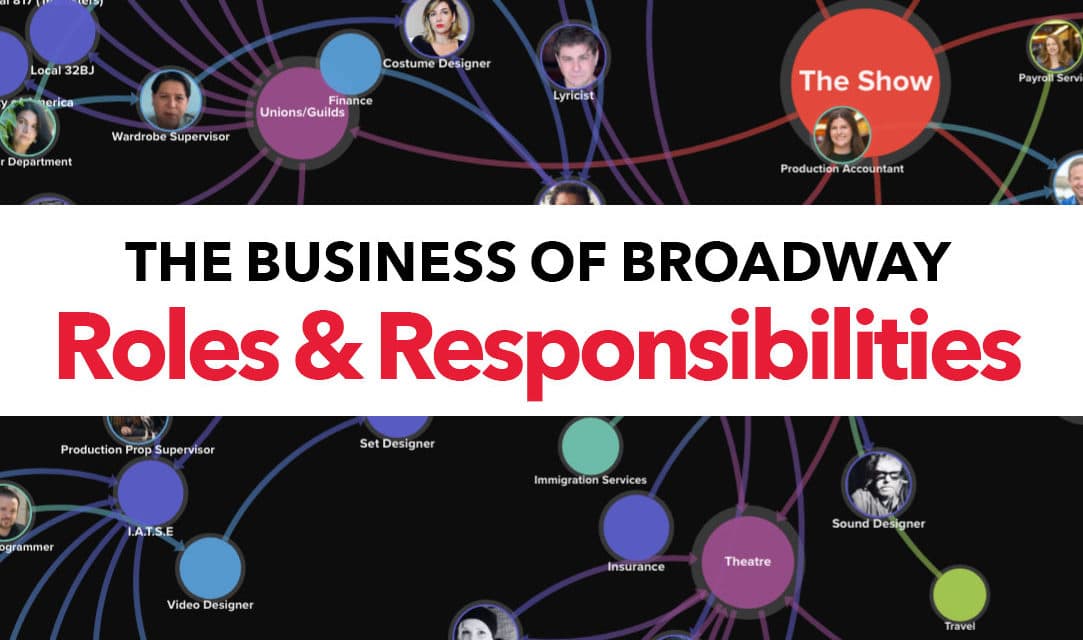No matter where you are in your writing process—from first draft to pitching to producers—having a working knowledge of the business side of the industry will prove beneficial. This new series entitled the “business of broadway” will help inform you about the personnel and processes that go into moving a show from page to stage.
Our first look is at the people who make theatre happen. Here is a breakdown of roles and responsibilities, along with an example and link to interviews to learn more.
Creative Team
- Playwright: the author of a play or dramatic work (e.g.: Paula Vogel)
- Bookwriter: the person who writes the book (script) to a musical work (e.g.: Winnie Holzman, Joe DiPietro)
- Librettist: the person who writes the book (script) and lyrics to a musical work (e.g. Rick Elice)
- Composer: the person who writes the score of a musical (e.g. Stephen Schwartz, Jeanine Tesori)
- Lyricist: the person who writes lyrics for a musical (e.g. Lynn Ahrens, Lin Manuel Miranda)
- Orchestrator: works with the Composer to bring the score to life and plans for the specific musical needs of a production. They determine how many musicians will play how many instruments, what those instruments will be, and what notes each of the instruments will play. (e.g. Larry Blank, Alex Lacamoire)
- Director: the person who oversees and orchestrates the mounting of a theatrical production by unifying various aspects of production (e.g. Rachel Chavkin, Casey Nicholaw)
- Choreographer: the person responsible for all dance and any movement not considered directorial blocking (e.g. Kathleen Marshall, Andy Blankenbuehler)
- Music Director: responsible for working with the stage director in preparing a theatre production for public performance, including casting, rehearsing the vocalists and orchestra, and conducting (and sometimes selecting) the orchestra. (e.g. Stephen Oremus, Meg Zervoulis, Andrea Grody)
- Dramaturg: contextualize the world of a play and establish connections among the text, actors, and audience (e.g. Ken Cerniglia, Marine Kei Green-Rogers)
- Actors: the people who portray one or more characters in a theatrical production (e.g. Eva Noblezada, Shereen Pimentel)
- Designers: the people who design and oversee aspects such as lighting (e.g. Natasha Katz, Howell Binkley, Brian MacDevitt), costumes (e.g. Susan Hilferty, Linda Cho, Clint Ramos ), sets (e.g. David Rockwell, David Gallo), sound (e.g. Alma Kelliher, Robert Kaplowitz), props (e.g. Kathy Fabian, Buist Bickley, Faye Armon-Troncoso), and hair, makeup and wigs (e.g. Joe Delude II, Brian Strumwasser, Paul Huntley)
- Casting Director: coordinates and runs the process by which the director and other key members of the creative team audition actors and assign roles (e.g. Rachel Hoffman, Benton Whitley, Telsey & Company)
Producers
- (Lead) Producer: the “CEO”— spearheads and supervises all aspects of the production process. Finds artistic work to develop, raises money, hires creative and business personnel (e.g. Tara Smith, Stacey Mindich, David Stone, Kevin McCollum, Sue Frost, Randy Adams)
- Co-Producers/Associate Producers: person or entity that raises money for a show (e.g. Sue Gilad, Janet Kagan, Jim Kierstead, Jana Robbins, Larry Rogowsky)
- Executive Producer: oversees all business and creative aspects of mounting a theatrical production on behalf of the Producer
Business
- Agents/Managers: Handle business matters for members of the creative team (e.g. Judy Boals)
- Production Attorney: Advise producer in business and legal matters
- General Manager: Acts as the day-to-day business manager of a production; manages budgets, financial reports, contracts and legal issues (under advice of production counsel), finding venues, and coordinating meetings. (e.g. Carol Pasbjerg, Frank Scardino)
- Company Manager: Reports to the General Manager; responsible for administrative matters including box office receipts, ticket discounts, and payroll. (e.g. Lee Poulin)
Advertising/Marketing/Publicity
- Advertising Agency: involved in the business of promoting the show and selling tickets (e.g. SpotCo)
- Marketing Manager: in charge of the promotion and representation of the production, public image, and branding of the show (e.g. Victoria Cairl)
- Press Agent/Agency: Engaged by producer to publicize a production using the press and other media channels (e.g. Chelsea Nachman)
Production
- Production Manager: in charge of everyone who is a part of the Production Team – costumes, sets, lighting, sound, props, etc. They tend to serve as the bridge between the administrative/artistic teams and the production staff. (e.g. Isaac Katzanek, Kate Coltun)
- Stage Manager: has overall responsibility of coordinating communication between various personnel, includes writing director’s notes, creating a show’s prompt book, runs daily production once show is open (e.g. Jereme Kyle Lewis, Glenn Turner)
- House Manager: responsible for front-of-house (from curtain line forward) and the physical plant of theater (e.g. Laurel Wilson)
- Stage Hand: works backstage or behind-the-scenes setting up scenery, lights (e.g. Patrick Rizzo), sound (e.g. Karen Zabinski), props, rigging, etc.
And there are COUNTLESS others whose talent, support and contribution makes a show possible.
Playbill.com and Situation Interactive created the Broadway Community Project to shine a spotlight on the sprawling, interconnected world of workers beyond the stage that help bring the stories we love to life.
Directions: Use the buttons at the top right of the map to zoom in and out. Drag to focus on a specific area. Click on each role to learn more about the job and meet a member of the Broadway community.
From Playbill.com:
The Broadway Community Project is a visual representation of the larger Broadway ecosystem and all the roles, organizations and small businesses that come together to build an industry that contributed over $14.7 billion to the New York economy in 2019, serving as a key driver for tourism.
By navigating this interactive tool, audience and industry members alike can explore and discover details about the artists and artisans, technicians and ticketers who help make Broadway the cultural heart of New York City through their passionate, tireless work. And most importantly, the map puts faces to the varied job titles and shares a personal, human story about those that make up the Broadway community and the role each of them play in creating the iconic status Broadway has around the world.
We hope you enjoy exploring and discovering more about the talented people who make Broadway the unique, wonderful world we all love.
For more information about the Broadway Community Project, visit www.playbill.com/broadway-community-project.
Another fantastic resource is the book “The Business of Broadway: An Insider’s Guide to Working, Producing, and Investing in the World’s Greatest Theatre Community.”



















